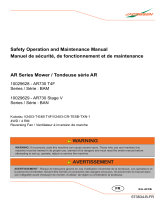
SAFETY 2
5
g The fuel nozzle must touch the rim of the fuel tank
when you add fuel to the mower. Do not use a
device to lock the fuel nozzle in the open position.
h Do not over fill the fuel tank. Leave at least 1 inch
(25 mm) below the filler neck.
i Always tighten the fuel tank cap and container cap
after you add fuel.
j If the fuel spills on your clothing, change your
clothing immediately.
MAINTENANCE AND STORAGE
a Before you clean, adjust or repair this equipment,
push PTO switch to the OFF position, lower the
cutting unit to the ground, engage the parking
brake, stop the engine and remove the key.
b Make sure the mower is parked on a solid and level
surface.
c Never work on a mower that is lifted only by the
jack. Always use the jack stands.
d Never allow persons to service the mower or its
attachments without correct instructions.
e When the mower is parked, put into storage or left
without an operator, lower the cutting device unless
a positive mechanical lock is used.
f When you put the mower on a trailer or put the
mower in storage, close the fuel valve. Do not keep
fuel near flames or drain the fuel inside a building.
g Disconnect the battery before you service the
mower. Always disconnect the negative battery
cable before the positive battery cable. Always
connect the positive battery cable before the
negative battery cable.
h Charge the battery in an area with good airflow.
The battery can release hydrogen gas that is
explosive. To prevent an explosion, keep any
device that can cause sparks or flames away from
the battery.
i Disconnect the battery charger from the power
supply before you connect or disconnect the
battery charger to the battery. Wear protective
clothing and use insulated tools when you service
the battery.
j Be careful and wear gloves when you check or
service the cutting unit blades. Replace any
damaged blades, do not try to correct a damaged
blade.
k Keep your hands and feet away from parts that
move. Do not adjust the mower with the engine in
operation, unless the adjustment needs the engine
in operation.
l Carefully release the pressure from components
with stored energy.
m To prevent injury from the hot, high pressure oil,
never use your hands to check for oil leaks. Use
the paper or cardboard to find leaks.
n The hydraulic fluid pressure can have enough
force to enter your skin. If hydraulic fluid has
entered your skin, a doctor must remove the
hydraulic fluid surgically within a few hours or
gangrene can occur.
o When you service the hydraulic system, make sure
the hydraulic fittings, tubes and hoses are
tightened to the correct torque. Make sure the
hydraulic system is in good condition before you
start the engine.
p Keep the mower and the engine clean.
q Allow the engine to become cool before storage
and always remove the ignition key.
r Keep all nuts, bolts and screws tight to make sure
the equipment is in safe condition.
s Replace worn or damaged parts for safety.
Replace damaged or worn decals. Only use parts,
accessories and attachments approved by
Jacobsen.
t To decrease the fire hazard, remove materials that
burn from the engine, muffler, battery tray and fuel
tank area.
u Disconnect the battery and controller connectors
before you weld on this mower.
WHEN YOU PUT THE MOWER ON A
TRAILER
a Be careful when you load or unload the mower on
a trailer. Trailer must be wider than the mower and
can carry the weight of the mower.
b Use a full-width ramp to load or unload the mower
on a trailer.
c Use straps, chains, cables or ropes to fasten the
mower to the trailer. Both front and rear straps
must be sent down and toward sides of trailer.
d Make sure that all latches are correctly fastened.





























